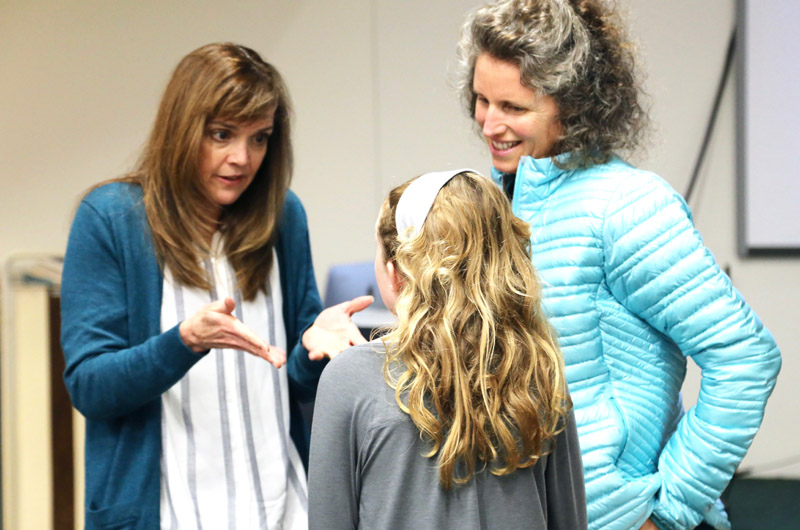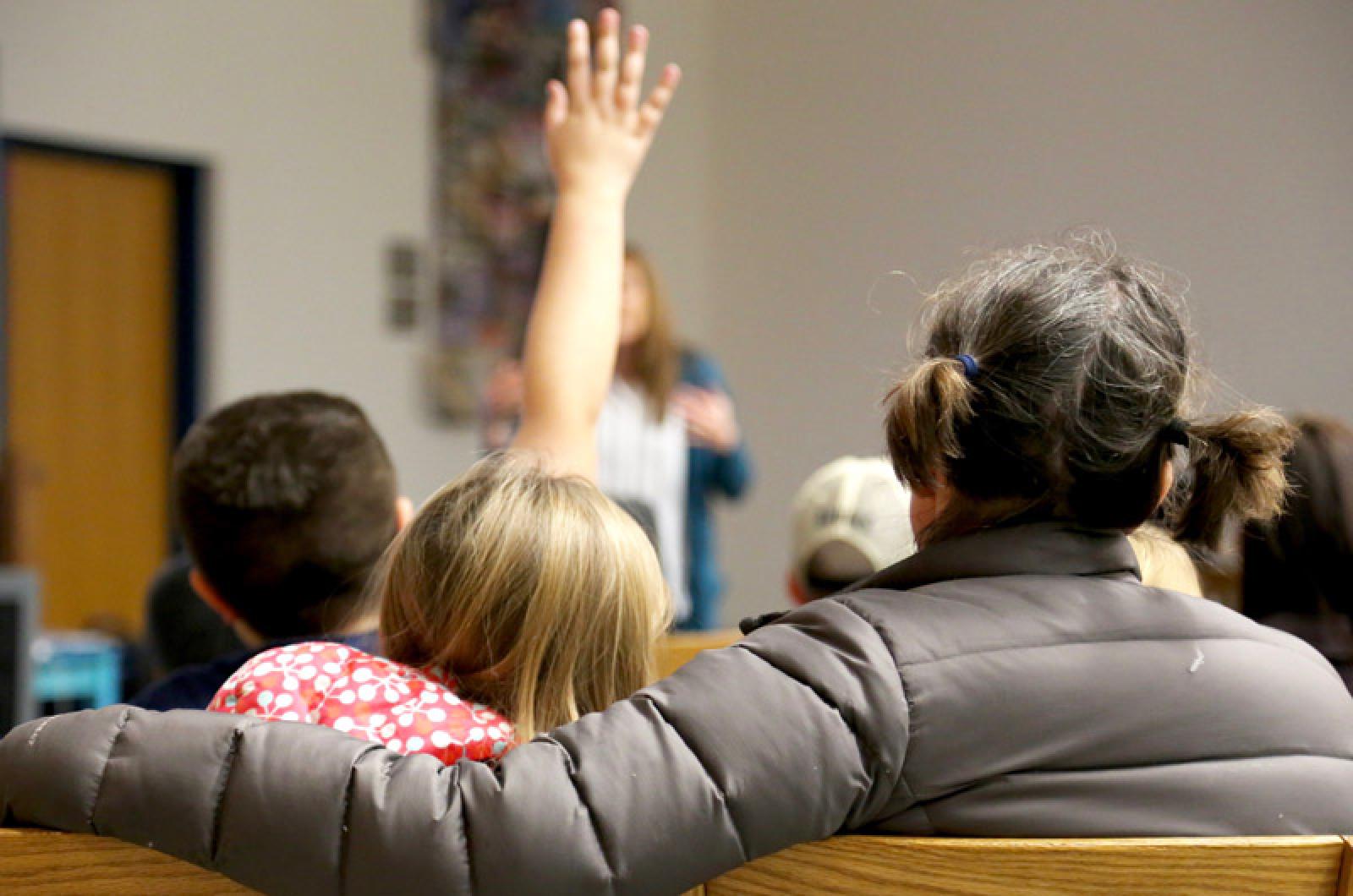Lynn Lyons doesn’t want you to calm down.
For much of her 27-year career, the Concord, N.H., therapist, author and speaker has studied anxiety and depression in kids and adults. In a series of workshops presented on the Island this week, the message she delivered about how to treat them may not be one you’ve heard before.
Speaking to a group of about 35 parents and kids ages 8 to 16 at the regional high school library Tuesday night, Ms. Lyons said while yoga, meditation and breathing exercises have become popular treatment options for those dealing with anxiety, a meditation-only regimen may be missing the point.
“I have nothing against breathing — keep breathing,” she assured the crowd, drawing ripples of laughter. “But we can handle being uncomfortable. Being uncomfortable is not a crisis.”
And being anxious feels uncomfortable. Using dynamic body language and role-playing games, she described the physiological responses involved when the body is triggered by an anxiety-provoking thought or event. Elevated heart rate, dilated pupils, even digestive issues can all be physical reactions to anxiety.

And while we all worry about different things, our responses to anxiety are the same.
“It’s not so important to me what you worry about,” Ms. Lyons said. “What matters is how you deal with the worry when it comes up.”
This approach — recognizing the physical presence of anxiety symptoms and learning to proceed in the face of them — often contradicts with other, more familiar therapeutic methods. Describing worry as an information-hungry cult-leader, Ms. Lyons said that while our first response may be to talk about the things that are worrying us, often prolonged discussion only makes things worse.
“If you’re in therapy and you’re talking about your problems all the time, you’re doing the disorder,” she said. Instead, worried kids and their parents should be looking at what can happen next. “What you want to talk about is the process,” she said.
“We have to normalize anxiety,” she said later in interview at the Island Wide Youth Collaborative, which has sponsored her visits to the Vineyard for the past three years, along with the Youth Task Force and Martha’s Vineyard Community Services Disability Services. “When you are in a situation that’s creating anxiety, instead of resisting it, shift your attitude to, all right, let’s go.”
At the workshop Tuesday night, kids made lists of the things that cause them anxiety. Some worried about doing well in school, sports and extra-curricular activities. Others worried about going to bed, and others were afraid of heights. But there was a common theme: each of the worries was a part of everyday life and not something they were easily going to avoid.
Ms. Lyons said a common mistake parents make is allowing their kids to stop doing the things that worry them. “If you’re worried about going to tennis, and you don’t go to tennis, then your worry gets what it wants,” she said.
She said children need to learn that it’s okay to try new things, even when they don’t have all the information. “For a chronic worrier, the information is never enough,” she said. “The need for information and reassurance is limitless. For parents the trap is providing the reassurances over and over and over.”
Instead, parents can promote autonomy and confidence in their children. “An assignment I often give is to have parents do an inventory of all of the things they are doing for their children, and stop doing three of those things now,” Ms. Lyons said.
Parents of worried children should also manage what she called safety chatter. “Too many ‘be carefuls’ and ‘watch outs’ can be a problem,” she said.
Language that normalizes and validates what children are feeling when they are anxious is critical, she said. “The two most important words you can use are ‘of course.’ Of course you’re feeling anxious.”
Anxiety and depression are very much on the minds of Island educators and social workers. The 2006 Island Health Report showed that the Island had a comparatively higher rate of mental illness (including anxiety and depression) and substance abuse than the national average.
The correlation between anxiety and substance abuse is one that Lyons often discusses with adolescent and parent groups, but the goal, she said, is to reach kids at younger and younger ages.
“Untreated anxiety disorder in a child is one of the top predictors of developing depression by the time you hit adolescence and adulthood,” Ms. Lyons said. “People get depressed about being anxious.”
Depression leads to isolation and withdrawal, which for many young people can in turn lead to substance abuse. “Social connection is so important to teenagers. And alcohol is hugely disinhibiting,” she said.
For younger kids and parents, Ms. Lyons offers fun and engaging tools to use at home. At the Tuesday evening workshop, she asked the kids to name their “worry parts” and give them physical characteristics. The answers were creative and included a potato with a face, a dentist’s mirror, and a loud, terrifying tennis ball named Salt.
Ten-year-old Waylon Sauer attended the workshop with his mother and was called on to role play his anxiety with Ms. Lyons. Waylon played himself, and Ms. Lyons dramatized his worry, described by Waylon as “a blue blob with a moustache, top hat and glasses named Phil.”
Waylon’s mother Wenonah Madison said she has attended the workshop before and always learns from it. “She approached all of this in a way I hadn’t heard before,” she said.
For Waylon, the idea of talking to the worry on his shoulder has helped. For his mom, it was learning to pay attention to what was happening to Waylon when he worried — emotionally and physically — and beginning to shift her focus away from what he was worrying about.
“It’s not about identifying the worry,” Ms. Madison said. “If you take away the trigger, they just transfer the worry to something else.”
Which is exactly the message Ms. Lyons hopes that all parents and kids she works with receive, and one she occasionally has to be reminded of herself. When asked what makes her worry, she has a standard response — “anything having to do with bones being not where they’re supposed to be.” But more recently she has been faced with a new challenge: sending her oldest son off to college.
“I pride myself on routinely not knowing where my children are,” Ms. Lyons joked of her generally laid-back parenting style. “But sending my son to college, I’ve really had to practice what I preach. He’s in a new place and doesn’t know a lot of people. When he worries about being lonely, I want so badly to jump in and fix it.”
What does she say instead?
“I say, of course you’re lonely,” she laughed. “I say, ‘is there anything you can be doing differently to connect?”




Comments (2)
Comments
Comment policy »